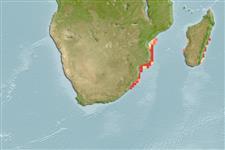Common names from other countries
Elasmobranchii (tubarões e raias) (sharks and rays) >
Carcharhiniformes (Ground sharks) >
Pentanchidae (Deepwater catsharks)
Etymology: Halaelurus: halos (Gr.), sea; ailouros (Gr.), cat, probably an allusion to the vernacular “catshark,” so named for its cat-like eyes. (See ETYFish); lineatus: Latin for lined, referring to its 13 pairs of narrow dark-brown stripes. (See ETYFish).
Environment: milieu / climate zone / depth range / distribution range
Ecologia
marinhas demersal; intervalo de profundidade 0 - 290 m (Ref. 5510). Subtropical; 19°S - 31°S
Western Indian Ocean: Beira, Mozambique to East London, South Africa.
Tamanho / Peso / Idade
Maturity: Lm ? range ? - ? cm
Max length : 56.0 cm TL macho/indeterminado; (Ref. 244); 52.0 cm TL (female)
Descrição suscinta
Chaves de identificação | Morfologia | Morfometria
Espinhos dorsais (total) : 0; Espinhos anais: 0. A catshark with an upturned knob on the snout, a narrow head, and numerous small dark spots on the body (Ref. 5578). Pale brown with numerous pairs of narrow, vertical, dark brown stripes outlining obscure dusky saddles (Ref. 5578), cream below (Ref. 5510).
Found on the continental shelf and uppermost slope, on soft bottoms, from close inshore to 290 m (Ref. 5578). Feeds on small crustaceans, bony fish, and cephalopods (Ref. 5578). Although commonly caught by shore anglers, it is not generally considered a game fish (Ref. 12484).
Ciclo de vida ou comportamento de acasalamento
Maturities | Reprodução | Spawnings | Egg(s) | Fecundities | Larvas
Probably lays eggs, with up to 16 egg-cases per female; eggs retained until embryos reach advanced stage of development (Ref. 5578).
Compagno, L.J.V., 1984. FAO Species Catalogue. Vol. 4. Sharks of the world. An annotated and illustrated catalogue of shark species known to date. Part 2 - Carcharhiniformes. FAO Fish. Synop. 125(4/2):251-655. Rome: FAO. (Ref. 244)
Status na Lista Vermelha da UICN (Ref. 130435)
CITES (Ref. 128078)
Not Evaluated
Ameaça para os humanos
Harmless
Uso pelos humanos
Pescarias: sem interesse; peixe esportivo: sim; Aquário: Aquários públicos
Ferramentas
Relatórios especiais
Baixar XML
Fontes da internet
Estimates based on models
Preferred temperature (Ref.
115969): 18.6 - 25.3, mean 22.7 (based on 22 cells).
Índice de diversidade filogenética (Ref.
82804): PD
50 = 0.5078 [Uniqueness, from 0.5 = low to 2.0 = high].
Bayesian length-weight: a=0.00269 (0.00144 - 0.00502), b=3.05 (2.88 - 3.22), in cm Total Length, based on LWR estimates for this species & (Sub)family-body (Ref.
93245).
Nível Trófico (Ref.
69278): 4.5 ±0.60 se; based on food items.
Resiliência (Ref.
120179): Baixo, tempo mínimo de duplicação da população 4,5 - 14 anos (Fec assumed to be <100).
Fishing Vulnerability (Ref.
59153): Moderate vulnerability (42 of 100).
